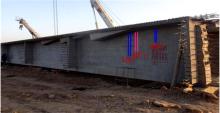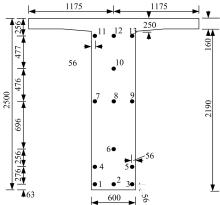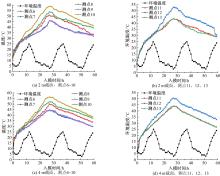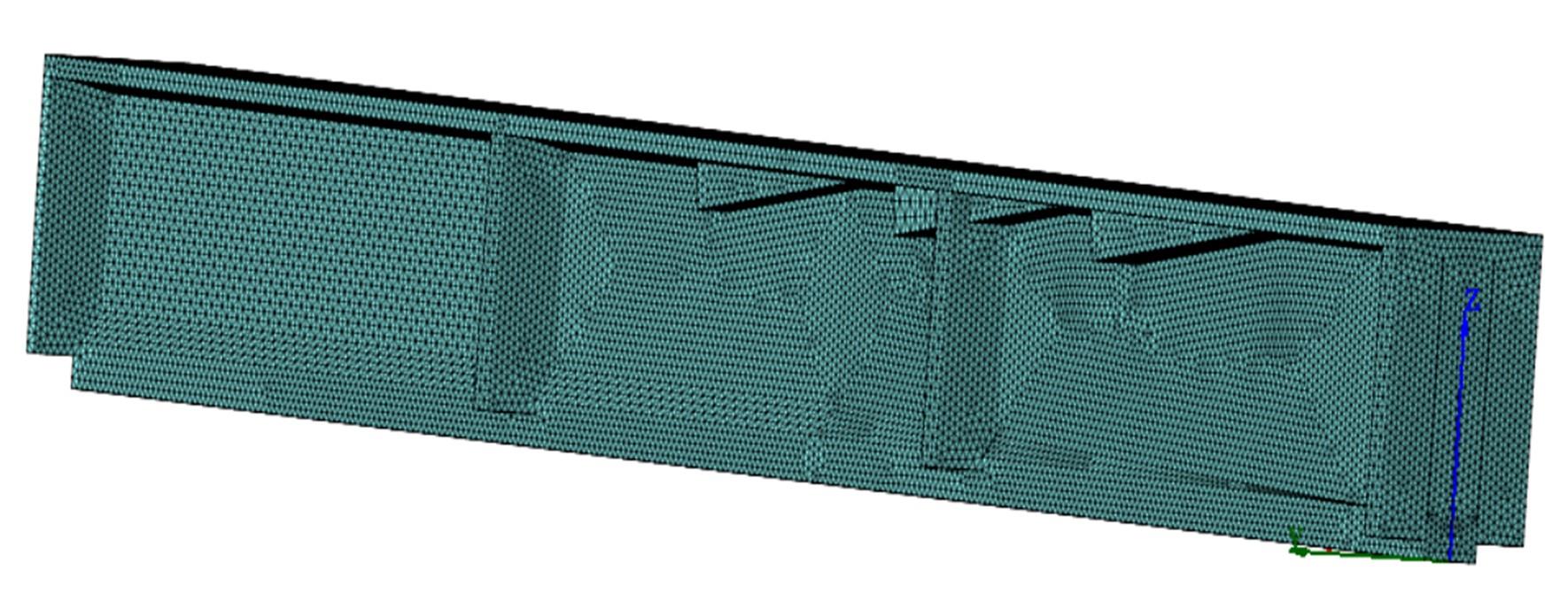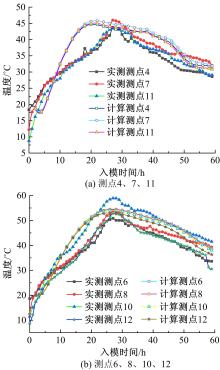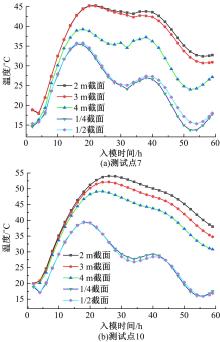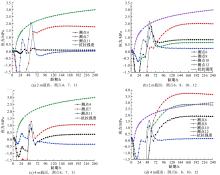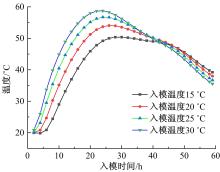吉林大学学报(工学版) ›› 2021, Vol. 51 ›› Issue (5): 1734-1741.doi: 10.13229/j.cnki.jdxbgxb20200599
• 交通运输工程·土木工程 • 上一篇
预制T梁早期水化热温度效应及梁端开裂机理
- 1.宁夏大学 土木与水利工程学院,银川 750021
2.宁夏交通建设股份有限公司,银川 750002
3.宁夏道路养护工程技术研究中心,银川 750001
Effect of hydration heat temperature and cracking mechanism of beam end in early stage of T⁃beam
Ying-xin HUI1,2,3( ),Xiao-rong SUN1,Hong-yu WANG1,Chen GAO1
),Xiao-rong SUN1,Hong-yu WANG1,Chen GAO1
- 1.School of Civil and Hydraulic Engineering,Ningxia University,Yinchuan 750021,China
2.Ningxia Communications Construction Co. ,Ltd. ,Yinchuan 750002,China
3.Ningxia Engineering Technology Research Center for Road Maintenance,Yinchuan 750002,China
摘要:
为避免预制混凝土T梁在施工养护期间产生较高的水化热而导致梁端出现早期竖向裂缝,以一座40 m预应力混凝土T梁为研究对象,对其浇筑过程水化热发展及早龄期力学性能进行监测与测试,并基于实测结果建立考虑梁段早期时变的精细化有限元模型,研究浇筑过程水化热温度场演变特征、梁端应力分布规律。结果表明:40 m跨预制T梁在混凝土浇筑初期,靠近梁端位置因水化过程中的温度迅速聚集而具有较高的开裂风险,且在距梁端2~4 m区域的腹板靠近翼缘板位置易贯通。建议控制入模温度在20 ℃以内并采用优化配合比的方法,减少水泥用量或采用低水化热水泥,以达到降低水化热和防止裂缝产生的目的。
中图分类号:
- U441
| 1 | 宿晓萍, 王清. 复合盐浸-冻融-干湿多因素作用下的混凝土腐蚀破坏[J]. 吉林大学学报: 工学版, 2015, 45(1): 112-120. |
| Su Xiao-ping, Wang Qing. Corrosion damage of concrete under multi-salt soaking, freezing-thawing and dry-wet cycles[J]. Journal of Jilin University(Engineering and Technology Edition), 2015, 45(1): 112-120. | |
| 2 | 张宁, 周鑫, 刘永健, 等. 基于点阵式测量的混凝土箱梁水化热温度场原位试验[J]. 土木工程学报, 2019, 52(3) :76-86. |
| Zhang Ning, Zhou Xin, Liu Yong-jian, et al. In-situ test on hydration heat temperature of box girder based on array measurement[J]. China Civil Engineering Journal, 2019, 52(3): 76-86. | |
| 3 | 戴公连, 岳喆. 混凝土箱梁早期温度测试与分析[J].武汉大学学报: 工学版, 2019, 52(2): 139-144. |
| Dai Gong-lian, Yue Zhe. Test and analysis of early temperature of concrete box girder[J]. Engineering Journal of Wuhan University, 2019, 52(2): 139-144. | |
| 4 | 顾斌, 陈志坚, 陈欣迪. 大跨径混凝土箱梁桥有效温度与应变的实测分析[J]. 吉林大学学报: 工学版, 2013, 43(4): 877-884. |
| Gu Bin, Chen Zhi-jian, Chen Xin-di. Analysis of measured effective temperature and strains of long-span concrete box girder bridge[J]. Journal of Jilin University(Engineering and Technology Edition), 2013, 43(4): 877-884. | |
| 5 | Taysi N, Abid S R. Temperature distributions and variations in concrete box-girder bridges: experimental and finite element parametric studies[J]. Advances in Structural Engineering, 2015, 4(18): 469-486. |
| 6 | Wang Y B, Zhan Y L, Zhao R D. Analysis of thermal behavior on concrete box-girder arch bridges under convection and solar radiation[J]. Advances in Structural Engineering, 2016, 19(7): 1043-1059. |
| 7 | 李昀. 预应力混凝土T梁裂缝成因分析与处理[J].铁道科学与工程学报, 2015, 12(2): 330-334. |
| Li Yun. Cause analysis and treatment of cracks in prestressed concrete T beams[J]. Journal of Railway Science and Engineering, 2015, 12(2): 330-334. | |
| 8 | 朱伯芳. 大体积混凝土温度应力与温度控制[M]. 北京: 中国电力出版社, 2012. |
| 9 | Zhu S Y, Cai C B. Interface damage and its effect on vibrations of slab track under temperature and vehicle dynamic loads[J]. International Journal of Non-Linear Mechanics, 2014, 58(1): 222-232. |
| 10 | 彭友松. 混凝土桥梁结构日照温度效应理论及应用研究[D]. 成都: 西南交通大学土木工程学院, 2007. |
| Peng You-song. Studies on theory of solar radiation thermal effects on concrete bridges with application [D]. Chengdu: College of Civil Engineering, Southwest Jiaotong University, 2007. | |
| 11 | Zhu J S, Meng Q L. Effective and fine analysis for temperature effect of bridges in natural environments[J]. Journal of Bridge Engineering, 2017, 22(6): 1-19. |
| 12 | 汪建群, 方志, 刘杰. 大跨预应力混凝土箱梁水化热测试与分析[J]. 桥梁建设, 2016, 46(5): 29-34. |
| Wang Jian-qun, Fang Zhi, Liu Jie. Measurement and analysis of hydration heat of long span PC Box- girders[J]. Bridge Construction, 2016, 46(5): 29-34. | |
| 13 | 朱伯芳. 水工混凝土结构的温度应力与温度控制[M]. 北京: 水科电力出版社, 1976. |
| 14 | 宋军, 石雪飞, 阮欣. 大体积混凝土热学参数识别的优化[J]. 吉林大学学报: 工学版, 2018, 48(5): 1418-1425. |
| Song Jun, Shi Xue-fei, Ruan Xin. Optimization of thermal parameter identification for mass concrete[J]. Journal of Jilin University(Engineering and Technology Edition), 2018, 48(5): 1418-1425. |
| [1] | 王金国,黄恺,闫瑞芳,任帅,王志强,郭劲. 元胞自动机-有限元法模拟碳当量元素对亚共晶球墨铸铁流动性的影响[J]. 吉林大学学报(工学版), 2021, 51(3): 855-865. |
| [2] | 刘纯国,于晓彤,岳韬,李东来,张明哲. 双曲率筋条壁板铣削回弹预测[J]. 吉林大学学报(工学版), 2021, 51(1): 188-199. |
| [3] | 熊二刚,徐涵,谭赐,王婧,丁若愚. 基于弹塑性应力场理论的钢筋混凝土梁受剪承载力[J]. 吉林大学学报(工学版), 2021, 51(1): 259-267. |
| [4] | 张艳芹,冯雅楠,孔鹏睿,于晓东,孔祥滨. 基于热油携带的静压支承油膜温度场及试验[J]. 吉林大学学报(工学版), 2019, 49(4): 1203-1211. |
| [5] | 李于朋,孙大千,宫文彪. 6082⁃T6铝合金薄板双轴肩搅拌摩擦焊温度场[J]. 吉林大学学报(工学版), 2019, 49(3): 836-841. |
| [6] | 周晓勤,杨璐,张磊,陈立军. 具有负压缩性的铰接八面体结构的有限元分析[J]. 吉林大学学报(工学版), 2019, 49(3): 865-871. |
| [7] | 宋军, 石雪飞, 阮欣. 大体积混凝土热学参数识别的优化[J]. 吉林大学学报(工学版), 2018, 48(5): 1418-1425. |
| [8] | 刘志峰, 赵代红, 王语莫, 浑连明, 赵永胜, 董湘敏. 重载静压转台承载力与油垫温度场分布的关系[J]. 吉林大学学报(工学版), 2018, 48(3): 773-780. |
| [9] | 王国林, 孙砚田, 梁晨, 杨建, 周海超. 应用满应力理论的轮胎轮廓设计[J]. 吉林大学学报(工学版), 2017, 47(2): 365-372. |
| [10] | 刘程, 史文库, 陈志勇, 何伟, 荣如松, 宋怀兰. 汽车驱动桥准双曲面齿轮齿根弯曲应力预测与试验[J]. 吉林大学学报(工学版), 2017, 47(2): 344-352. |
| [11] | 邵晴, 徐涛, 徐从占, 郭昊添, 郭桂凯, 张海博. 基于聚醚醚酮保持架的角接触球轴承特性仿真[J]. 吉林大学学报(工学版), 2017, 47(1): 163-168. |
| [12] | 闫光, 庄炜, 刘锋, 祝连庆. 具有增敏效果的光纤光栅应变传感器的预紧封装及传感特性[J]. 吉林大学学报(工学版), 2016, 46(5): 1739-1745. |
| [13] | 胡玉明, 黄音, 古海东. 排桩支护结构内力与变形三维有限元数值分析[J]. 吉林大学学报(工学版), 2016, 46(2): 445-450. |
| [14] | 肖湘, 黄恩厚, 尼颖升. 预应力混凝土梁板体系有效翼缘的理论分析及试验[J]. 吉林大学学报(工学版), 2015, 45(6): 1784-1790. |
| [15] | 史栋勇1, 2, 盈亮3, 胡平1, 3, 申国哲3, 武文华2, 姜大鑫3. 高强度钢板热成形三维温度场数值模拟分析[J]. 吉林大学学报(工学版), 2014, 44(4): 946-952. |
|
||
